VQ VAE
Vector-quantized variational autoencoder (VQ VAE) is a generative model that uses vector quantization to learn discrete latent representations.
Papers and Code
TokenSeg: Efficient 3D Medical Image Segmentation via Hierarchical Visual Token Compression
Jan 08, 2026Three-dimensional medical image segmentation is a fundamental yet computationally demanding task due to the cubic growth of voxel processing and the redundant computation on homogeneous regions. To address these limitations, we propose \textbf{TokenSeg}, a boundary-aware sparse token representation framework for efficient 3D medical volume segmentation. Specifically, (1) we design a \emph{multi-scale hierarchical encoder} that extracts 400 candidate tokens across four resolution levels to capture both global anatomical context and fine boundary details; (2) we introduce a \emph{boundary-aware tokenizer} that combines VQ-VAE quantization with importance scoring to select 100 salient tokens, over 60\% of which lie near tumor boundaries; and (3) we develop a \emph{sparse-to-dense decoder} that reconstructs full-resolution masks through token reprojection, progressive upsampling, and skip connections. Extensive experiments on a 3D breast DCE-MRI dataset comprising 960 cases demonstrate that TokenSeg achieves state-of-the-art performance with 94.49\% Dice and 89.61\% IoU, while reducing GPU memory and inference latency by 64\% and 68\%, respectively. To verify the generalization capability, our evaluations on MSD cardiac and brain MRI benchmark datasets demonstrate that TokenSeg consistently delivers optimal performance across heterogeneous anatomical structures. These results highlight the effectiveness of anatomically informed sparse representation for accurate and efficient 3D medical image segmentation.
SafeMo: Linguistically Grounded Unlearning for Trustworthy Text-to-Motion Generation
Jan 02, 2026Text-to-motion (T2M) generation with diffusion backbones achieves strong realism and alignment. Safety concerns in T2M methods have been raised in recent years; existing methods replace discrete VQ-VAE codebook entries to steer the model away from unsafe behaviors. However, discrete codebook replacement-based methods have two critical flaws: firstly, replacing codebook entries which are reused by benign prompts leads to drifts on everyday tasks, degrading the model's benign performance; secondly, discrete token-based methods introduce quantization and smoothness loss, resulting in artifacts and jerky transitions. Moreover, existing text-to-motion datasets naturally contain unsafe intents and corresponding motions, making them unsuitable for safety-driven machine learning. To address these challenges, we propose SafeMo, a trustworthy motion generative framework integrating Minimal Motion Unlearning (MMU), a two-stage machine unlearning strategy, enabling safe human motion generation in continuous space, preserving continuous kinematics without codebook loss and delivering strong safety-utility trade-offs compared to current baselines. Additionally, we present the first safe text-to-motion dataset SafeMoVAE-29K integrating rewritten safe text prompts and continuous refined motion for trustworthy human motion unlearning. Built upon DiP, SafeMo efficiently generates safe human motions with natural transitions. Experiments demonstrate effective unlearning performance of SafeMo by showing strengthened forgetting on unsafe prompts, reaching 2.5x and 14.4x higher forget-set FID on HumanML3D and Motion-X respectively, compared to the previous SOTA human motion unlearning method LCR, with benign performance on safe prompts being better or comparable. Code: https://github.com/AIGeeksGroup/SafeMo. Website: https://aigeeksgroup.github.io/SafeMo.
Hierarchical Vector-Quantized Latents for Perceptual Low-Resolution Video Compression
Dec 31, 2025The exponential growth of video traffic has placed increasing demands on bandwidth and storage infrastructure, particularly for content delivery networks (CDNs) and edge devices. While traditional video codecs like H.264 and HEVC achieve high compression ratios, they are designed primarily for pixel-domain reconstruction and lack native support for machine learning-centric latent representations, limiting their integration into deep learning pipelines. In this work, we present a Multi-Scale Vector Quantized Variational Autoencoder (MS-VQ-VAE) designed to generate compact, high-fidelity latent representations of low-resolution video, suitable for efficient storage, transmission, and client-side decoding. Our architecture extends the VQ-VAE-2 framework to a spatiotemporal setting, introducing a two-level hierarchical latent structure built with 3D residual convolutions. The model is lightweight (approximately 18.5M parameters) and optimized for 64x64 resolution video clips, making it appropriate for deployment on edge devices with constrained compute and memory resources. To improve perceptual reconstruction quality, we incorporate a perceptual loss derived from a pre-trained VGG16 network. Trained on the UCF101 dataset using 2-second video clips (32 frames at 16 FPS), on the test set we achieve 25.96 dB PSNR and 0.8375 SSIM. On validation, our model improves over the single-scale baseline by 1.41 dB PSNR and 0.0248 SSIM. The proposed framework is well-suited for scalable video compression in bandwidth-sensitive scenarios, including real-time streaming, mobile video analytics, and CDN-level storage optimization.
Quantum Generative Models for Computational Fluid Dynamics: A First Exploration of Latent Space Learning in Lattice Boltzmann Simulations
Dec 27, 2025This paper presents the first application of quantum generative models to learned latent space representations of computational fluid dynamics (CFD) data. While recent work has explored quantum models for learning statistical properties of fluid systems, the combination of discrete latent space compression with quantum generative sampling for CFD remains unexplored. We develop a GPU-accelerated Lattice Boltzmann Method (LBM) simulator to generate fluid vorticity fields, which are compressed into a discrete 7-dimensional latent space using a Vector Quantized Variational Autoencoder (VQ-VAE). The central contribution is a comparative analysis of quantum and classical generative approaches for modeling this physics-derived latent distribution: we evaluate a Quantum Circuit Born Machine (QCBM) and Quantum Generative Adversarial Network (QGAN) against a classical Long Short-Term Memory (LSTM) baseline. Under our experimental conditions, both quantum models produced samples with lower average minimum distances to the true distribution compared to the LSTM, with the QCBM achieving the most favorable metrics. This work provides: (1)~a complete open-source pipeline bridging CFD simulation and quantum machine learning, (2)~the first empirical study of quantum generative modeling on compressed latent representations of physics simulations, and (3)~a foundation for future rigorous investigation at this intersection.
GQ-VAE: A gated quantized VAE for learning variable length tokens
Dec 26, 2025While most frontier models still use deterministic frequency-based tokenization algorithms such as byte-pair encoding (BPE), there has been significant recent work to design learned neural tokenizers. However, these schemes generally add to underlying language model complexity and force large changes to architecture, making them hard to implement at large scales. To overcome these challenges, we propose the gated quantized variational autoencoder (GQ-VAE), a novel architecture that can be independently pre-trained to serve as a drop-in replacement for existing tokenizers. The key innovation of the architecture is to learn to encode variable-length discrete tokens. GQ-VAE improves compression and language modeling performance over a standard VQ-VAE tokenizer, and approaches the compression rate and language modeling performance of BPE. Interestingly, if we use BPE with a smaller vocabulary, such that the compression is equivalent between GQ-VAE and BPE, we find that GQ-VAE improves downstream language model learning. We conclude with a discussion of several exciting avenues for future work. Code can be found at https://github.com/Theo-Datta-115/gq-vae.
Towards Unified Co-Speech Gesture Generation via Hierarchical Implicit Periodicity Learning
Dec 15, 2025Generating 3D-based body movements from speech shows great potential in extensive downstream applications, while it still suffers challenges in imitating realistic human movements. Predominant research efforts focus on end-to-end generation schemes to generate co-speech gestures, spanning GANs, VQ-VAE, and recent diffusion models. As an ill-posed problem, in this paper, we argue that these prevailing learning schemes fail to model crucial inter- and intra-correlations across different motion units, i.e. head, body, and hands, thus leading to unnatural movements and poor coordination. To delve into these intrinsic correlations, we propose a unified Hierarchical Implicit Periodicity (HIP) learning approach for audio-inspired 3D gesture generation. Different from predominant research, our approach models this multi-modal implicit relationship by two explicit technique insights: i) To disentangle the complicated gesture movements, we first explore the gesture motion phase manifolds with periodic autoencoders to imitate human natures from realistic distributions while incorporating non-period ones from current latent states for instance-level diversities. ii) To model the hierarchical relationship of face motions, body gestures, and hand movements, driving the animation with cascaded guidance during learning. We exhibit our proposed approach on 3D avatars and extensive experiments show our method outperforms the state-of-the-art co-speech gesture generation methods by both quantitative and qualitative evaluations. Code and models will be publicly available.
ARGenSeg: Image Segmentation with Autoregressive Image Generation Model
Oct 23, 2025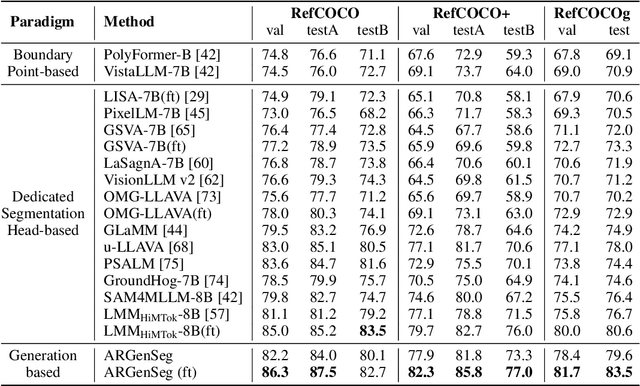
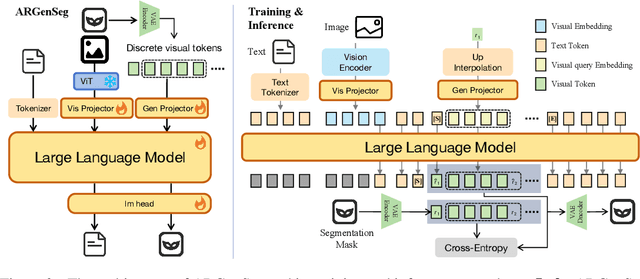


We propose a novel AutoRegressive Generation-based paradigm for image Segmentation (ARGenSeg), achieving multimodal understanding and pixel-level perception within a unified framework. Prior works integrating image segmentation into multimodal large language models (MLLMs) typically employ either boundary points representation or dedicated segmentation heads. These methods rely on discrete representations or semantic prompts fed into task-specific decoders, which limits the ability of the MLLM to capture fine-grained visual details. To address these challenges, we introduce a segmentation framework for MLLM based on image generation, which naturally produces dense masks for target objects. We leverage MLLM to output visual tokens and detokenize them into images using an universal VQ-VAE, making the segmentation fully dependent on the pixel-level understanding of the MLLM. To reduce inference latency, we employ a next-scale-prediction strategy to generate required visual tokens in parallel. Extensive experiments demonstrate that our method surpasses prior state-of-the-art approaches on multiple segmentation datasets with a remarkable boost in inference speed, while maintaining strong understanding capabilities.
VAEVQ: Enhancing Discrete Visual Tokenization through Variational Modeling
Nov 10, 2025Vector quantization (VQ) transforms continuous image features into discrete representations, providing compressed, tokenized inputs for generative models. However, VQ-based frameworks suffer from several issues, such as non-smooth latent spaces, weak alignment between representations before and after quantization, and poor coherence between the continuous and discrete domains. These issues lead to unstable codeword learning and underutilized codebooks, ultimately degrading the performance of both reconstruction and downstream generation tasks. To this end, we propose VAEVQ, which comprises three key components: (1) Variational Latent Quantization (VLQ), replacing the AE with a VAE for quantization to leverage its structured and smooth latent space, thereby facilitating more effective codeword activation; (2) Representation Coherence Strategy (RCS), adaptively modulating the alignment strength between pre- and post-quantization features to enhance consistency and prevent overfitting to noise; and (3) Distribution Consistency Regularization (DCR), aligning the entire codebook distribution with the continuous latent distribution to improve utilization. Extensive experiments on two benchmark datasets demonstrate that VAEVQ outperforms state-of-the-art methods.
Precoder Design in Multi-User FDD Systems with VQ-VAE and GNN
Oct 10, 2025
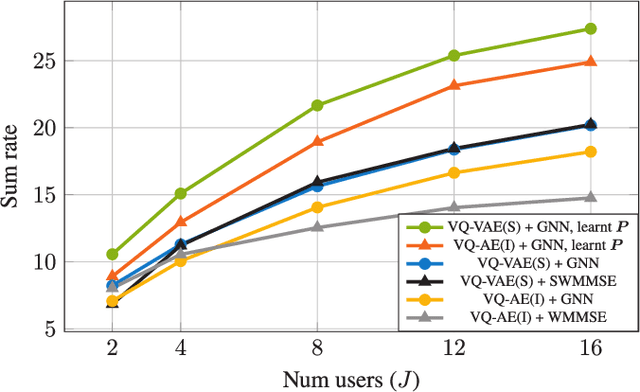
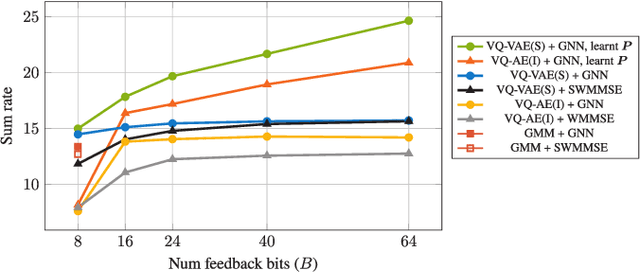
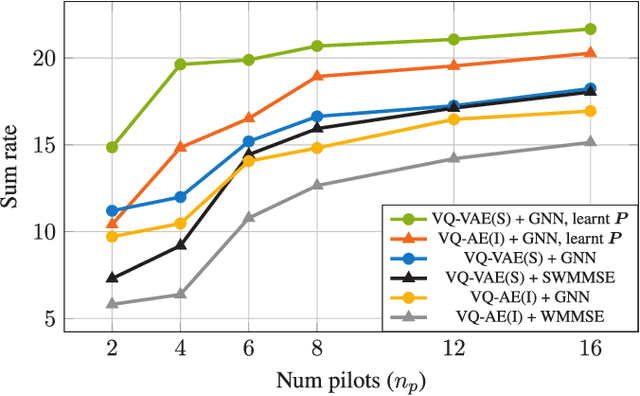
Robust precoding is efficiently feasible in frequency division duplex (FDD) systems by incorporating the learnt statistics of the propagation environment through a generative model. We build on previous work that successfully designed site-specific precoders based on a combination of Gaussian mixture models (GMMs) and graph neural networks (GNNs). In this paper, by utilizing a vector quantized-variational autoencoder (VQ-VAE), we circumvent one of the key drawbacks of GMMs, i.e., the number of GMM components scales exponentially to the feedback bits. In addition, the deep learning architecture of the VQ-VAE allows us to jointly train the GNN together with VQ-VAE along with pilot optimization forming an end-to-end (E2E) model, resulting in considerable performance gains in sum rate for multi-user wireless systems. Simulations demonstrate the superiority of the proposed frameworks over the conventional methods involving the sub-discrete Fourier transform (DFT) pilot matrix and iterative precoder algorithms enabling the deployment of systems characterized by fewer pilots or feedback bits.
DiVeQ: Differentiable Vector Quantization Using the Reparameterization Trick
Sep 30, 2025Vector quantization is common in deep models, yet its hard assignments block gradients and hinder end-to-end training. We propose DiVeQ, which treats quantization as adding an error vector that mimics the quantization distortion, keeping the forward pass hard while letting gradients flow. We also present a space-filling variant (SF-DiVeQ) that assigns to a curve constructed by the lines connecting codewords, resulting in less quantization error and full codebook usage. Both methods train end-to-end without requiring auxiliary losses or temperature schedules. On VQ-VAE compression and VQGAN generation across various data sets, they improve reconstruction and sample quality over alternative quantization approaches.
 Add to Chrome
Add to Chrome Add to Firefox
Add to Firefox Add to Edge
Add to Edge